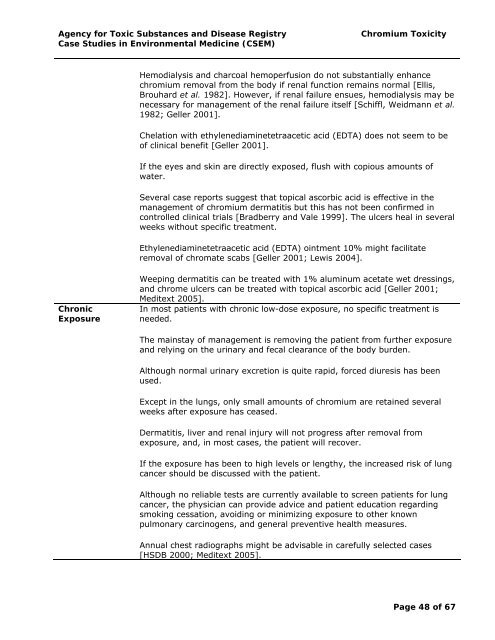(Cr) Toxicity | ATSDR - CSEM - Agency for Toxic Substances and ...
(Cr) Toxicity | ATSDR - CSEM - Agency for Toxic Substances and ...
(Cr) Toxicity | ATSDR - CSEM - Agency for Toxic Substances and ...
Create successful ePaper yourself
Turn your PDF publications into a flip-book with our unique Google optimized e-Paper software.
<strong>Agency</strong> <strong>for</strong> <strong>Toxic</strong> <strong>Substances</strong> <strong>and</strong> Disease Registry Chromium <strong><strong>Toxic</strong>ity</strong><br />
Case Studies in Environmental Medicine (<strong>CSEM</strong>)<br />
Chronic<br />
Exposure<br />
Hemodialysis <strong>and</strong> charcoal hemoperfusion do not substantially enhance<br />
chromium removal from the body if renal function remains normal [Ellis,<br />
Brouhard et al. 1982]. However, if renal failure ensues, hemodialysis may be<br />
necessary <strong>for</strong> management of the renal failure itself [Schiffl, Weidmann et al.<br />
1982; Geller 2001].<br />
Chelation with ethylenediaminetetraacetic acid (EDTA) does not seem to be<br />
of clinical benefit [Geller 2001].<br />
If the eyes <strong>and</strong> skin are directly exposed, flush with copious amounts of<br />
water.<br />
Several case reports suggest that topical ascorbic acid is effective in the<br />
management of chromium dermatitis but this has not been confirmed in<br />
controlled clinical trials [Bradberry <strong>and</strong> Vale 1999]. The ulcers heal in several<br />
weeks without specific treatment.<br />
Ethylenediaminetetraacetic acid (EDTA) ointment 10% might facilitate<br />
removal of chromate scabs [Geller 2001; Lewis 2004].<br />
Weeping dermatitis can be treated with 1% aluminum acetate wet dressings,<br />
<strong>and</strong> chrome ulcers can be treated with topical ascorbic acid [Geller 2001;<br />
Meditext 2005].<br />
In most patients with chronic low-dose exposure, no specific treatment is<br />
needed.<br />
The mainstay of management is removing the patient from further exposure<br />
<strong>and</strong> relying on the urinary <strong>and</strong> fecal clearance of the body burden.<br />
Although normal urinary excretion is quite rapid, <strong>for</strong>ced diuresis has been<br />
used.<br />
Except in the lungs, only small amounts of chromium are retained several<br />
weeks after exposure has ceased.<br />
Dermatitis, liver <strong>and</strong> renal injury will not progress after removal from<br />
exposure, <strong>and</strong>, in most cases, the patient will recover.<br />
If the exposure has been to high levels or lengthy, the increased risk of lung<br />
cancer should be discussed with the patient.<br />
Although no reliable tests are currently available to screen patients <strong>for</strong> lung<br />
cancer, the physician can provide advice <strong>and</strong> patient education regarding<br />
smoking cessation, avoiding or minimizing exposure to other known<br />
pulmonary carcinogens, <strong>and</strong> general preventive health measures.<br />
Annual chest radiographs might be advisable in carefully selected cases<br />
[HSDB 2000; Meditext 2005].<br />
Page 48 of 67

















